Lee Moller's Blog, page 11
January 9, 2019
Brain that Changes Itself, The; Norman Doidge; 2007; Penguin Books; 284 pgs; appendices; notes, index
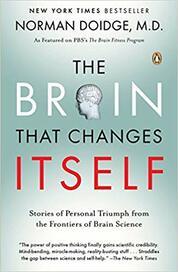 This is an interesting book, recommended to me by my friend D. Harper. It starts out very strong with a story about a woman who had lost her balance. That is, her vestibular complex had been destroyed and she had no balance. She felt like she was in a permanent state of free fall. If she stood, she fell immediately. Then they put a small accelerometer under her tongue. The accelerometer would raise and lower bumps on the tongue contact to indicate how her head was moving. Miraculously, it worked. She was walking again in a short time, and could ultimately get by without the device for most for the day.
This is an interesting book, recommended to me by my friend D. Harper. It starts out very strong with a story about a woman who had lost her balance. That is, her vestibular complex had been destroyed and she had no balance. She felt like she was in a permanent state of free fall. If she stood, she fell immediately. Then they put a small accelerometer under her tongue. The accelerometer would raise and lower bumps on the tongue contact to indicate how her head was moving. Miraculously, it worked. She was walking again in a short time, and could ultimately get by without the device for most for the day.Her brain had rewired itself to take balance input not from the ear, but from her tongue! That is neuroplasticity, the subject of the book. This is NOT neuro-linguistic programming (NLP) which is a crock.
As a computer scientist, I see computing analogies all over the place in this book. All your senses act as "ports", the technical term for how data gets into a computer. It turns out if one port breaks, the brain can, with some work, relocate the input to another port. A great deal is made of the topological nature of the brain. What this means is that there is a map of your body (to pick one example), in your brain. This is no surprise. It means that if you touch yourself on two adjacent parts of your leg, there will to two adjacent parts of your brain that "light up".
Some pithy conclusions:
Neurons that fire together wire together.Use it or loose it.Neurons that fire apart wire apart.Neurons out of sync fail to link.
These ideas imply a lot of possibilities. The brain is a big de-localized computing machine. If parts die, the functions can be relocated. If parts are not busy, they will get seconded for other uses. For example when you are blind your hearing improves, using bits (literally and figuratively) of our visual cortex for help. Knowing these mechanisms has led to real treatments for injured people.
I have little doubt, for example, that my brain map for my hands has gotten larger since I started practicing close up magic. The same would be true for learning to play an instrument.
The book starts out strong with deeply interesting experiments and outcomes, and finishes with weak examples that to me are little more than simple learning (which, of course, also changes your brain). Just imagining things (like rehearsing in your head) can make long lasting changes to your brain.
One take away: Learn new stuff. All the time. It will keep your brain healthy longer… and you are your brain. If your memory is getting iffy, exercise it!
Published on January 09, 2019 14:47
December 19, 2018
Words to Live By
Perhaps I'm old and tired, but I think that the chances of finding out what's actually going on are so absurdly remote that the only thing to do is to say, "Hang the sense of it," and keep yourself busy. I'd much rather be happy than right any day.
Slartibartfast, The Hitchhiker's Guide to the Galaxy
Slartibartfast, The Hitchhiker's Guide to the Galaxy
Published on December 19, 2018 11:38
November 30, 2018
The Fifth Risk; Michael Lewis; 2018; W. W. Norton; 219 pgs; no index
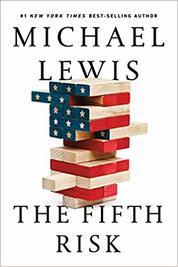 Michael Lewis has written some great books (Moneyball, The Big Short etc). I cannot really count this one among them. Nevertheless, it was interesting. Heavy leading and lots of white space make the 219 pages a short read.
Michael Lewis has written some great books (Moneyball, The Big Short etc). I cannot really count this one among them. Nevertheless, it was interesting. Heavy leading and lots of white space make the 219 pages a short read.This book a basically a collection of anecdotes about Trump taking power.
The first section focuses on the DOE. When Trump took power, he resented having to spend money on transitions (which he is required to do by law). He wanted to keep the money for himself! As a result, there was no smooth transition between administrations. Quite the opposite, in fact.
The first thing the Trump administration asked for was a list of DOE names that had attended any climate related discussions!
Like all departments, the DOE had prepared a primer on what the role of the DOE was. But no one showed up to see it! Rick Perry attended a meeting to brief him. He spent mere minutes familiarizing himself with the department. One official was ousted from her physical office by Eric Trump's brother in law who took it. No one knew why.
The DOE does a lot of things, like making sure reactors don't melt down, and that no bomb material "gets lost". Over the years, the DOE has recovered enough material to make 160 bombs. It is populated by some very smart people. They made sure, for example, that Iran lived up to its part of the deal… until Trump killed the deal. Trump likes to do things in half measures. DOE interviewees point out the dangers of cutting corners, and the huge risks involved when you do.
It is hard to build a fence. It is easy to knock it down. And it is stupid to knock it down if you don't understand why it is there.
The same story unfolded at the USDA (Department of Agriculture). Everyone was waiting to hand over power, and no one showed up… for a month. Soon, the USDA board was occupied by a long haul trucker, an AT&T clerk, a gas company meter reader and a cabana boy. The USDA is responsible for a lot of things, like crops, and nutrition, food stamps etc., and it is now being run by the least competent people imaginable who all hate climate change
The Department of Commerce sounds dull. It does have trade responsibilities, but mostly it is a data bank (data from agencies like NOAA and NASA). Information is their currency. And they have a lot of it. They got the same treatment as the other departments. Wilbur Ross runs it. He and Trump are cut from the same cloth.
Fun fact: Really rich people do not want to be listed in the Forbes 500. Only three in the history of the magazine have fought to get on the list: Saudi Prince Alwaleed, Donald Trump and Wilbur Ross!
The problem is this: Scientific data can be used for many things. Like predicting weather to help farmers make timely planting decisions for example. Huge amounts of data were made public, and scientists used that data to make the world better (you will have to read the book for details), but Trump et al smelled climate change, removed all references to it from all web sites, and removed the aforementioned data from the cloud.
There is an interesting conflict building. AccuWeather gets its data from the feds. But they make money selling that information and the feds give it away for free. So AccuWeather sought to stop the feds from doing that.
Soon, you can expect to see headlines like "Hurricane coming! If you want to know where and when, subscribe to AccuWeather now!".
It will take many years to undo the damage that Trump has done to the US and the world.
Published on November 30, 2018 11:28
October 1, 2018
When Prophecy Fails; Leon Festinger, Henry Riecken, Stanley Schachter; 1950s?;
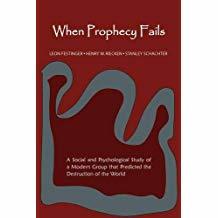 This is an odd book. It was published, but is now vanity published. The only date on the book reflects the day I ordered it. My attention was drawn to this book by Dale Beyerstein, my philosopher on call. We were discussing religious belief and he mentioned that this book might be of interest.
This is an odd book. It was published, but is now vanity published. The only date on the book reflects the day I ordered it. My attention was drawn to this book by Dale Beyerstein, my philosopher on call. We were discussing religious belief and he mentioned that this book might be of interest.The subject of the book is Armageddon, and why people buy into it. More specifically, why do they keep on believing, and in many cases, believe even more when the predicted date for the end of days is just followed by, well... more days.
The feeling you get when this happens is called cognitive dissonance, a term Dale Beyerstein thinks may have been coined by the authors. Cognitive dissonance happens when you "know" two contradictory things are true. The contradiction must be resolved. If you know the world will end on Tuesday, then you will experience CD on Wednesday.
The book asks why belief seems to grow after an utter failure of prophecy. For this to happen, the book argues that there are 5 necessary conditions to be met:
There must be conviction to the idea;There must be commitment to the conviction (e.g.: selling all your stuff);It must be falsifiable (i.e.: we can know that the predicted event did not take place);The event must fail to happen;Social support must be available after the non-event (i.e.: to explain why it did not happen and how they were actually still right even though they were just proved wrong).
The book focuses almost exclusively on a bunch of nuts who see the end of days coming pretty much all the time. The head nut was a woman name Kelly who received "spirit writing" about the end of the world. The group was known as the Seekers. The whole movement was wrapped up paranormal powers, Scientology, UFOs (which were in vogue at the time), and the nuts who believe in them, etc. A real mish mash of ideas. I could not handle the narrative about all this. Endless detail, too many crazies and too many crazy ideas.
The books conclusions are interesting and controversial. The controversy comes from embedding people in the group to help better understand them. But to get in, you had to prove you to were a nut… and if you got in fast it was probably because you had a story so compelling that they wanted you in. And the next thing you know, you are the poster boy for the movement, and not a dispassionate reported. And you are corrupting the group (a psychological Schrödinger's cat). The authors were well aware of this problem.
Published on October 01, 2018 10:23
September 17, 2018
Russian Roulette; Micheal Isikoff, David Corn; 2017; Hachette Book Group; 305 pgs, notes, index
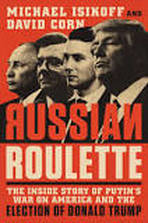 I borrowed this book from my brother. My usual habit is to highlight sections of interest as I read a book and use them as notes to create my own notes. But it is not my book, so this will be brief.
I borrowed this book from my brother. My usual habit is to highlight sections of interest as I read a book and use them as notes to create my own notes. But it is not my book, so this will be brief.The is largely a fact heavy book. I was reminded of much and learned a little. If you want to see a good review of just how deep Trump is, or might be, in cahoots with the Russians, this is the book. I had a renewed sense of outrage over Trump cozying up to ambassador Kislyak and inviting him into the Oval Office.
In many ways, the book is premature as the Russian connection is still being explored. Manafort has just turned on Trump as I write, so there are probably new tales to be told.
One largely unanswered question was why the Obama administration dragged it feet in blowing the whistle on Russian interference in the election.
Along the way, the book reminds us of Clinton's difficulties during the election. The general view of the Clintons as influence peddlers and money/power grubbers was briefly reinforced.
I read it from cover to cover, so that says something. If you are into the details, this is a good book to turn to; for more arm-wavy scary stories, I suspect (I have not read it yet) Woodward's book is the better bet.
Published on September 17, 2018 13:35
September 4, 2018
Chasing New Horizons; Alan Stern and David Grinspoon; 2016; Picador ebook; 273 pgs; pics, index
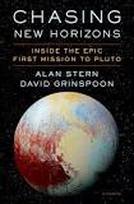 This is the story of the last first-look planetary probe to demoted mini-plant Pluto.
This is the story of the last first-look planetary probe to demoted mini-plant Pluto.It took about 20 years to complete the mission. NASA politics, federal politics, scientific priorities, and launch windows impact the plot heavily. We call know how it turned out. New Horizons blew past Pluto at 30,000+ mph, snapping pictures like mad, pointing to where it hoped Pluto and its moons were at the time. Almost five hours later, a message arrived back at NASA, basically saying "Got it!".
Pluto turned out to have 5 moons and was itself not a boring snowball, but a geologically active world with tons of stuff to see.
New Horizons is the little space ship that could. It was tiny compared to Voyager. Its antenna could not rotate independent of the cameras, which meant when the probe was busy, it could not talk to Earth, and when it was talking to Earth, it could not do anything else.
Just a few days before closest approach, the main computer crashed and the backup took over. The computer had found itself overloaded and it bailed, which is reminiscent of the Apollo 11 computer overload that almost ended the first moon walk mission. As a consequence, the entire software package that drove all the mission science had to be re-uploaded. They had to sacrifice a few minor experiments, but they got the job done. In one exchange, a scientist asked about priorities. Her's was one of the experiments that may have to be abandoned in order to fix the ship. The reply was: Focus on the main mission goals. There was no argument and no tears. Everyone understood what was a stake and that was that. Would that politicians could be so egalitarian.
A launch goes through a few obvious phases: Project approval (a lot of politics and competing scientific priorities); Building the gizmo; Launch; Approach; and End Game. There is usually a lot of time between Launch and Approach… in this case about a decade. During that period, one of the authors studied how things might go wrong. One possible issue was the New Horizons mirror image on Earth. This device was identical to the real New Horizons and was used as a test bed for all software uploads. He reasoned that if it were to fail, and something were to go wrong in space, fixing it would be much harder. So he called for a second backup unit to be built. If it were not for the availability of this backup, the software reloads described in the preceding paragraph may not have been possible.
The story of New Horizons is full of science, exploring spirit, pit falls, recoveries, and miracle rescues. Real drama billions of miles from Earth! New Horizons is now millions of miles past Pluto, heading for an encounter with a Kuiper Belt Object (KBO… this book has a lot of acronyms) in December 2019.
Two things worked for New Horizons. One was cheap computing power that meant that the machine could deal with most problems itself. The other was that they went by Jupiter, but did not go near Jupiter (which is a very dangerous area for unshielded electronics).
One of the great things about science is that it is apolitical. No one cares what your sex, or sexuality is, or about where you were born, or any of that other stuff. Everyone there was pulling on the same rope together, and all were ecstatic when the mission paid off.
I read it for just that perspective and quite enjoyed the read.
Published on September 04, 2018 11:37
August 4, 2018
Dinosaurs: A Concise Natural History; Fastovsky and Weishampel; 2012; Cambridge University Press; 375 pgs; Index, glossary
 We live in the age or mammals. Or do we? Birds are literally dinosaurs and there are twice as many species of birds as mammals. So perhaps we still live in the Age of Dinosaurs. And if we do, you should know a little of how it came about.
We live in the age or mammals. Or do we? Birds are literally dinosaurs and there are twice as many species of birds as mammals. So perhaps we still live in the Age of Dinosaurs. And if we do, you should know a little of how it came about.Here is how it did NOT happen: It did not happen 6,000 years ago, but 220 million years ago. It did not happen in the twitch of the lips of Barbara Eden. It happened after the table was set (which took place over billions of years) and dinosaurs evolved over 160 million years before most disappeared.
This is a straight up university text book. It is the best one out there that I know of. It is full of a lot of terminology, dates, bones, pictures, bios etc. A fulsome coverage of the state of knowledge of Dinosaurs and their kin.
In the last half century or so, the number of Dinosaur genera has doubled. If you would like the answers to what they ate, when they lived, how they survived, how warm was their blood; how they chewed, ran, walked, raised their young, digested, etc and how we think we know this stuff… this is the book.
It is pretty dry of you are not interested in the topic. I liked it.
Published on August 04, 2018 13:30
July 23, 2018
A recent review
I borrowed it from the library and really enjoyed it. I admired that you didn’t mention the don-the-con once!
Barbara Burnet
Barbara Burnet
Published on July 23, 2018 10:41
May 29, 2018
I'll be Gone in the Dark; Michelle McNamara; 2017; Harper Collins; 328 pgs; no index
 The book is not particularly my cup of tea. Nevertheless, I enjoyed it, despite the sad subject. The Golden State Killer, also known as the East Area Rapist, raped and killed from the 70s until just recently when he was caught. An ex-cop! Michelle died in 2016 before the book was started.
The book is not particularly my cup of tea. Nevertheless, I enjoyed it, despite the sad subject. The Golden State Killer, also known as the East Area Rapist, raped and killed from the 70s until just recently when he was caught. An ex-cop! Michelle died in 2016 before the book was started.I saw Patten Oswald, the author's widower, on a talk show and was intrigued. The book was stitched together from McNamara's extensive research and writings on the GSK. In fact, she provided the moniker. She was obsessed with this particular case. She maintained a crime web site for many years. She was tireless in her quest to see the GSK put away. Endless interviews, site visits and so on were her bread and butter.
She had written published articles on the subject, as well as several partially complete essays, and reams of notes and thoughts. These were compiled together into this book.
Her writing is excellent. The subject matter is gruesome, but she never allowed the reader to get drawn too deep into the darkness. Unfortunately, other parts of the books are not her words directly. The narrative jumps about in time, which is confusing, is it tries to pull the pieces together.
Reading about young women (and couples), attacked, bound, psychologically tortured, and often finally raped and killed is pretty hard.
The GSK was finally found by submitting DNA to a commercial DNA ancestry tracing service. The bad guy turned out to be a cop. Surprised? I am not. Rape is about exercising power and control over others. That is practically the job description of a cop.
The book is engrossing and despite that fact that I knew how it was to end, enjoyable (and disturbing). It is a real shame that the murderer was caught just after her death and the release of the book. She earned the right to see the story's ending.
Published on May 29, 2018 15:49
Relativity: The Special and General Theory; Albert Einstein; 1916; Digireads; 77 pgs;
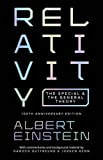 This is the great man's attempt to explain the two theories to the lay person in 1916. The treatment of Special Relativity is more or less complete and not hard to follow.
This is the great man's attempt to explain the two theories to the lay person in 1916. The treatment of Special Relativity is more or less complete and not hard to follow.Aside: No real math is involved in the book. But a good physical imagination does not hurt.
The treatment of the General Theory is quite cursory, mostly because the General Theory is much, much more complex that the Special Theory.
I have read such explanations many times. It was interesting to read them in Einstein's own (translated) words.
The only point of interest for me is noting that, in 1916, the metaphor for rapid travel was railroads. When it came to freefall (zero-g), there were no comparators. Today, the idea of weightlessness is common, and a spaceship is the usual vehicle for motion related metaphors.
Einstein used basic physics, and a preternatural ability to cut to the bone of an argument, to take the fact that the speed of light is constant regardless of you motion and turn it into a simple paper that was not fully accepted by his fellow physicists for another decade.
Published on May 29, 2018 15:44



